Crafting Your Own Longboard: A Complete Guide
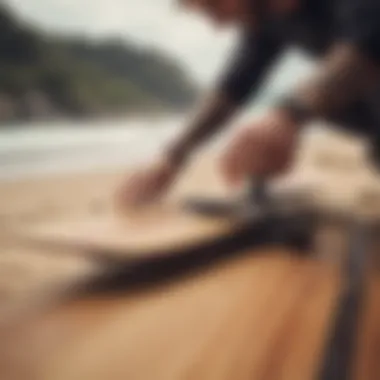
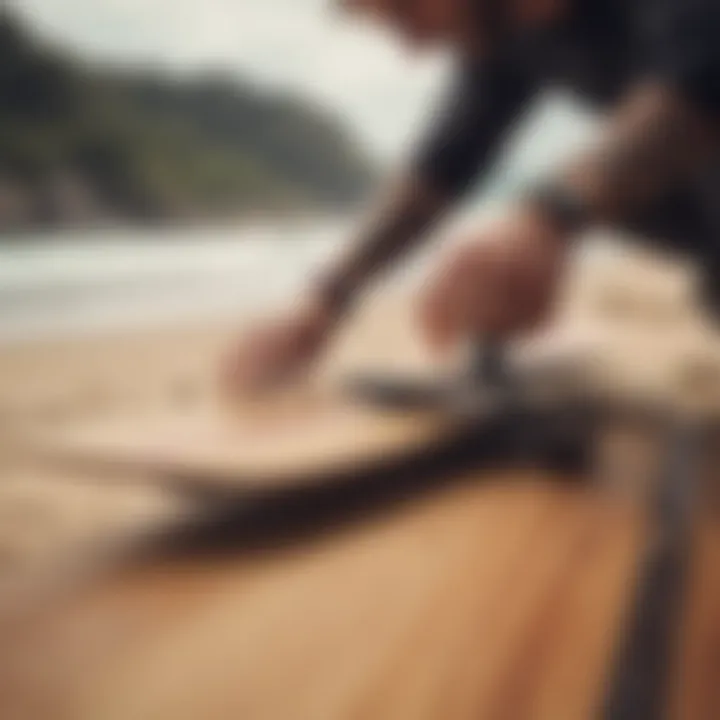
Intro
Creating a longboard is not simply about stacking parts together and calling it a day. It is a meticulous journey that combines art, science, and personal preference, all while catering to different riding styles. Those who venture into the realm of longboard crafting discover an endless array of choices—from the materials used to the design intricacies that can significantly shape the riding experience.
By understanding every layer of construction, enthusiasts can personalize their boards to suit their unique style and needs. This guide aims to serve as a comprehensive roadmap, leading you through the labyrinth of longboard creation. Whether you're just kicking off your adventure in woodworking or you're a seasoned craftsman looking to enhance your skills, the insights shared here provide an invaluable reference point.
Surfboarding Techniques
Longboarding techniques are pivotal since they directly impact your performance and enjoyment while riding. Mastering the basics can set you apart from the crowd, and even seasoned surfers can glean new tips from established methods. Here's a closer look at both ends of the spectrum.
Beginner Tips for Mastering the Basics
- Posture is Key: Stand with your feet shoulder-width apart and keep your knees slightly bent. This stance offers stability and balance, essential for a smoother ride.
- Pushing Off: Use your back foot to push against the ground while your front foot stays on the board. This technique will help you gain momentum without losing balance.
- Turning: To initiate a turn, lean in the direction you wish to go. A gentle bend of your knees can help pivot the board smoothly.
Engaging in these foundational techniques not only equips you to handle your board effectively but also boosts confidence as you navigate through different terrains.
Advanced Techniques for Seasoned Surfers
- Carving: Carving involves a series of like staged turns that utilize the edges of the board. It's both a technique and an art, requiring an understanding of weight distribution and balance.
- Slide Stops: Perfecting the slide stop technique can save you from abrupt stops. It involves shifting your weight to your back foot while simultaneously dragging your back foot to create friction, slowing down your momentum smoothly.
- Tight Turns: For those daring enough, practicing tight turns can significantly impact your carving. Leaning deeply into the turn, while maintaining control, elevates your ride's finesse.
"Mastering advanced techniques can be the difference between a casual ride and an exhilarating experience."
Longboard Equipment
Understanding the equipment needed for crafting your longboard can determine how well your board performs. Quality matters, and with the right gear, your ride can go from mundane to magnetic.
Essential Gear for Every Longboarder
- Deck Material: Choose between maple, bamboo, or composite materials. The choice impacts flexibility, weight, and aesthetic appeal.
- Trucks: Opt for trucks that fit the width of your deck appropriately. This can drastically change your riding feel, especially when turning.
- Wheels: Different wheel sizes and hardness levels cater to various terrains and riding preferences. Softer wheels, for instance, are more forgiving on rough surfaces.
- Bearings: Select high-speed bearings to ensure your wheels spin with minimal friction, making rides smoother and faster.
By focusing on both techniques and equipment, you’re not just assembling a longboard; you’re crafting an experience tailored to you.
Prologue to Longboarding
Longboarding, while often seen as merely a recreational activity, is a nuanced discipline that combines art, science, and passion. In this segment, we dive into the essence of longboarding, shedding light on why it's not just about gliding down a street but about embracing a culture that values creativity and craftsmanship.
Understanding Longboarding
At its core, longboarding is about freedom—a chance to carve your path, literally and figuratively. Unlike traditional skateboards, longboards typically feature a longer deck and larger wheels. This design allows for smoother rides and greater stability, especially when dealing with downhill slopes or rough terrains. When riders choose to build their own longboards, they embark on a journey that teaches them not only about the mechanics of their rides but also about the interplay between design and functionality.
The benefits of understanding the fundamentals of longboarding are manifold:
- Customization: Crafting your own longboard gives the rider an opportunity to personalize everything from the shape to the graphics.
- Skill Development: Building involves practical skills like measuring, cutting, and sanding - honing abilities that translate to other areas.
- Community Connection: Engaging in longboarding often fosters relationships amongst like-minded individuals who share a love for the art, making it a social activity.
Ultimately, knowing the nitty-gritty of longboarding enhances the overall riding experience, making each glide down the street feel uniquely one’s own.
Historical Context and Evolution
Longboarding has its roots deep in the skate culture of the late 1950s and early '60s, a period when surfers looked to capture the thrill of riding waves on land. Pioneers fashioned makeshift boards using wooden planks and roller skate wheels, setting a course for what would become a thriving subculture.
As time passed, advancements in materials and design transformed longboarding. The introduction of various materials—ranging from flexible composites to bamboo—allowed for diverse shapes and sizes, providing riders with options tailored to different styles and preferences. The evolution from simple handcrafted boards to highly engineered products speaks volumes about the growing interest and investment in this sport.
Today, longboarding is not just a pastime; it has burgeoned into a sport with dedicated competitions, specialized events, and even a following that extends globally. Riders today benefit from a rich history that shapes their experiences and offers them a plethora of choices in how they engage with the sport.
"Understanding the past of longboarding gives riders a greater appreciation for the craft and a deeper connection to fellow enthusiasts."
Through this exploration of longboarding's evolution, it becomes clear that building a personal longboard is a small act against a larger canvas of history and innovation. This journey allows riders not only to participate in a contemporary culture but also to carry forward a legacy seasoned with creativity and resilience.
Material Selection
When it comes to crafting your own longboard, the choice of materials is nothing short of pivotal. The right materials not only influence the board's durability and aesthetics but also play a critical role in how it performs on different terrains. Whether you're rolling through the city streets or carving along coastal paths, the materials you select will shape your experience. For budding builders and seasoned pros alike, knowing what each option brings to the table—literally—can make or break your longboarding journey.
Types of Wood
Choosing the right type of wood can give your longboard unique characteristics that cater to your specific riding style.
Plywood
Plywood is a well-known contender in the longboard universe for many reasons. One of its most striking aspects is its versatility; it can be manufactured with different layers that can accommodate various weight and flex needs. Its layered construction allows it to distribute weight evenly, which can be essential for stability.
The main advantage of plywood is its cost-effectiveness. It tends to be more affordable compared to other woods like maple or bamboo. Great for beginners who want to experiment without breaking the bank. However, while plywood does offer decent flexibility, it doesn't have the same resilience as some other materials. Over time, with heavy use, plywood may show signs of wear and tear more quickly.
Bamboo
Bamboo has become a favored material for those looking for both sustainability and performance. Its natural elasticity gives it a unique shock-absorbing quality, making for a smoother ride, especially on bumpy roads. Plus, it’s often lighter than both plywood and maple, making it a popular choice for commuters.
A unique feature of bamboo is its rapid growth; it's one of the most sustainable materials available. You can ride knowing your board is eco-friendly without compromising performance. That said, bamboo boards may require a bit more care to protect against moisture, as they could warp if not properly maintained.
Maple
Maple is often considered the gold standard in longboard wood. Its sturdy nature allows for a strong and rigid deck that's particularly suited for downhill riding. The dense fiber structure of maple provides excellent traction and handling, which many experienced riders appreciate when carving through corners at high speeds.
However, the trade-off tends to be weight. Maple boards can be heavier than plywood or bamboo, making them less ideal for those looking to carry their longboard around town. Still, for those who prioritize stability and control, the benefits often outweigh the drawbacks.
Alternative Materials
In the pursuit of creating an innovative longboard, alternative materials are worth exploring as they can offer different benefits and unique qualities.
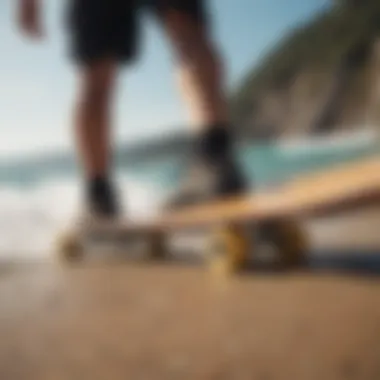

Composite Materials
Composite materials are an interesting mix of various elements that combine to establish a strong, lightweight board. Often made with a blend of fiberglass and epoxy resin, they can respond beautifully to both flex and stiffness, making them quite adaptable for different riding techniques. Lightness becomes a significant advantage here, especially for fast rides or tricks.
Another key characteristic is their resistance to water damage, meaning they can withstand elements better than pure wood options. But, the downside is that they can be pricier. For those who are serious about their craft and are willing to invest in performance, composite materials are worth considering.
Recycled Options
Recycled materials are making waves in the longboarding scene, as they symbolize a commitment to both innovation and environmental responsibility. Options made from recycled plastics or repurposed wood can produce unique designs, often infused with character that sets each board apart.
These materials can offer a surprising level of durability. However, they can vary significantly in terms of performance and might require more research to determine what works best for your needs. Skating on something that's not only exciting but also better for the planet adds a layer of satisfaction that resonates with many riders.
Choosing the right material is just the beginning of a journey into longboard craftsmanship, but it sets the groundwork for what’s to come—performance, style, and sustainability all wrapped into one ride.
In this exploration of material selection, one finds a world full of possibilities. Each option presents its distinct advantages, and the path you choose reflects your priorities as a rider. Grab your tools and dive into the hearty choices awaiting you!
Tools Required
When diving into building your own longboard, the tools you choose play a crucial role in determining the quality and outcome of your ride. Without the right equipment, even the finest materials can fall flat. Tools can either make or break the construction process, affecting both efficiency and safety. Understanding the specific tools needed not only helps in streamlining your workflow, but it also ensures that your longboard is safe and robust enough for all your thrilling adventures. Therefore, it’s essential to have the correct tools ready at hand before starting your building journey.
Essential Tools for Longboard Building
Saw
A saw is one of the first tools you'll reach for when kickstarting your longboard project. It’s all about precision and control while shaping the deck. A jigsaw or a circular saw usually stands out as the top choices for this job. The unique feature of a jigsaw is its ability to make intricate cuts, which is vital if you're looking to create a custom shape that speaks to your style. Its compactness allows you to maneuver it easily around tight corners—something a circular saw simply can’t do.
However, you must pay heed to blade choices. A fine-toothed blade suited for wood ensures a smoother cut which reduces the need for extensive sanding afterward. On the flip side, using a rougher blade can lead to jagged edges, necessitating more follow-up work, which can be annoying.
Sandpaper
Once the outline of your longboard is cut, sandpaper comes into play. This tool isn’t just a nice-to-have; it’s absolutely necessary for giving your board a smooth, polished finish. Different grits serve different purposes: coarse grits help in shaping while finer grits produce a sleek surface that's ready for your grip tape.
The real beauty of sandpaper is that it can be applied in various stages of your longboard’s creation, ensuring that every curve and corner is smooth to the touch. A quick tip is to use a sanding block to maintain even pressure while sanding, which provides a more consistent finish.
But beware, using excessively coarse sandpaper can harm your deck’s wood, taking away too much material. So, approach this step thoughtfully to protect your design’s integrity.
Drill
When it comes time to mount the trucks onto your deck, a drill will become your best friend. A quality drill can save you loads of time and effort during this part of your longboarding adventure. Its ability to create precise holes ensures that the trucks sit exactly where you want them.
Drills can vary, but a cordless option often stands out for its portability and ease of use. A drill with adjustable speed settings empowers you to make clean holes without damaging the wood. Being gentle is crucial here; too much force can lead to cracks and splintering, jeopardizing your longboard’s performance.
However, investing in drill bits specifically designed for wood is wise since they provide cleaner cuts than standard options. The risk here is using the wrong bit and damaging your carefully crafted deck. Take that extra moment to select wisely.
Safety Equipment
Just like having the right tools is essential, prioritizing safety cannot be overlooked. When using equipment that poses a risk—like saws and drills—protective gear is a must. This section covers crucial safety gear to keep you safe while creating your longboard.
Eye Protection
Eye protection is not just some box to check; it’s a lifeline. When you’re sawing or drilling, tiny splinters and dust can easily fly into your eyes, and trust me, that’s no fun. Investing in a good pair of safety goggles can make a world of difference.
The main draw of using safety goggles is their snug fit, ensuring that no debris can sneak in. While some might find them uncomfortable, try to choose a pair that feels light yet secure. You might end up forgetting you're even wearing them. The downside? They can fog up, especially during those long working sessions, so a pair with anti-fog features is something to consider.
Dust Masks
Dust masks are often sidelined but are crucial for anyone cutting or sanding wood. The fine particles released during these processes can irritate your lungs if inhaled. A basic paper dust mask can suffice, but many builders opt for respirators for improved protection.
The unique component of a good dust mask is its ability to filter out microscopic particles, allowing you to work comfortably without coughing fits. Just don't forget to change them out regularly, especially after heavy sanding or cutting. The downside is the comfort level; some masks can feel restrictive, but it’s a small price to pay for your health and safety.
Always prioritize safety gear when building your longboard, as it not only assists in the crafting process but helps avoid accidents and injuries.
Design Concepts
When it comes to longboarding, design is not just about looking good. It plays a pivotal role in how the board feels and performs. Understanding the intricacies of design concepts is essential for anyone looking to craft their own longboard. Every choice, from the shape to graphics, influences the riding experience and can optimize performance for various styles.
Shape and Size Considerations
The shape and size of your longboard are often the first decisions a builder must tackle. These attributes determine not only how the board rides but also how it handles different terrains. For instance, a wider board may provide more stability when cruising downhill, while a narrower design could enhance agility for tricks and sharper turns.
When pondering shape, you must consider the outline: is it more elongated or compact? An elongated board is suited for high speeds, as it generally reduces wind resistance. Conversely, a compact shape may enhance maneuverability, making it easier to perform tricks.
Here's a brief overview of popular shapes:
- Cruisers - Typically longer with a wider stance, providing stability for casual riding.
- Freestyle Boards - Shorter and more playful, allowing for tricks and technical maneuvers.
- Downhill Boards - Designed for speed, these boards are longer, with a lower center of gravity.
The choice of size not only affects performance but also the rider’s comfort. A board that is too small may feel unstable, while one that is too large can be cumbersome. Riders should test a few sizes to find what fits them best.
"The beauty of design lies in its balance between form and function. Every curve matters."
Graphics and Personalization
Once the foundational shape and size have been determined, it’s time to dive into the aesthetics. Graphics can elevate your longboard from a simple tool of transport to an expression of personality. Whether through hand-painted designs or vinyl stickers, personal art can transform a mundane board into a true masterpiece.
Customization doesn’t end at the surface. Colors, patterns, and themes reflect your personal journey and style. Here are some factors to consider while personalizing your longboard:
- Color Scheme: What emotions does each color evoke? Consider colors that resonate with you or represent your riding style.
- Art Style: From minimalist designs to intricate illustrations, how does one convey their personality?
- Durability: Ensure that the materials you use can withstand the elements. Consider using waterproof paints or high-quality stickers.
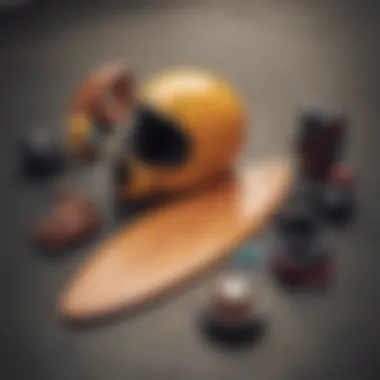
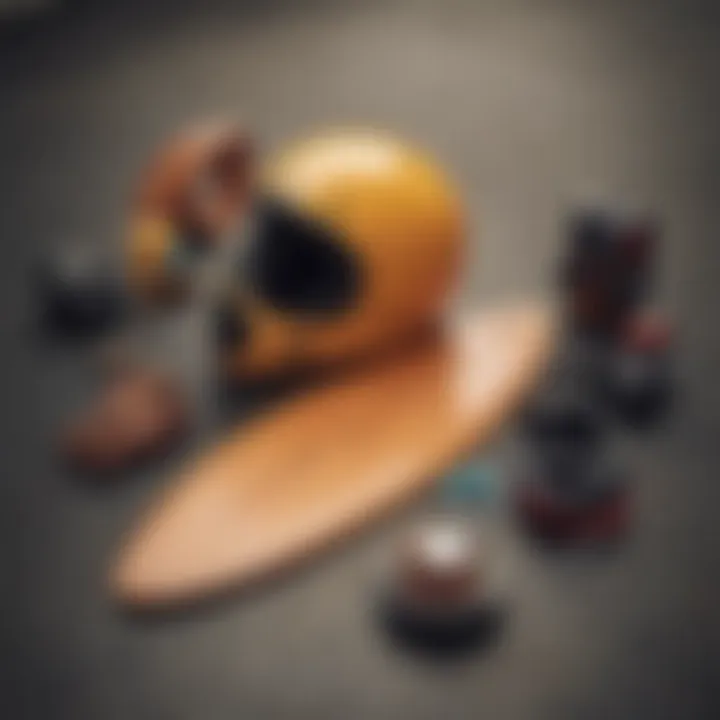
By giving thought to graphics and personal touches, not only do you create visual interest, but you also forge a deeper connection to your craft. Your longboard then becomes an extension of your identity, a canvas on wheels.
In crafting a longboard, embracing the nuances of design concepts isn’t just beneficial—it’s essential. Thoughtful choices in shape, size, and personalization lead to a more enjoyable and tailored riding experience, setting the stage for memorable adventures ahead.
Step-by-Step Building Process
When it comes to making your own longboard, diving straight into crafting might feel a bit overwhelming. However, the step-by-step building process is crucial, as it breaks down the whole complex task into manageable chunks. Each phase of construction plays its part in ensuring the final outcome meets your expectations and provides a great riding experience. Following these steps helps you stay organized and confident, allowing creativity to flow while ensuring that the techniques used are efficient and effective. Moreover, understanding and implementing this structured approach leads to a more fulfilling longboarding journey.
Creating the Deck
Creating the deck is the crux of longboard-building. It not only sets up the foundation for your ride but also influences balance, stability, and style. Essentially, how you shape this critical component can make or break your whole experience on the board.
Shaping the Outline
Shaping the outline of your longboard deck is an important first step. The outline determines the overall form and design of the board. A well-shaped outline is recognized for its ability to enhance maneuverability, while a poorly shaped outline can restrict movement and affect performance.
One key characteristic when shaping the outline is that it’s highly customizable. You can opt for a more symmetrical shape for stability or a more elongated design for speed. A unique feature of outlining is that it’s about creating a visual identity as well as function. The major advantage here is how a well-thought-out shape can lead to a smoother ride, especially in varying terrains. However, a downside could be the potential for a learning curve if you're new to the technique, making this step both exciting and challenging.
Sanding Techniques
Sanding techniques follow closely after outlining and serve a multi-faceted purpose. The act of sanding may seem straightforward, but it’s crucial in shaping the tactile experience the rider will have. When sanding, the emphasis is on achieving a smooth finish that feels comfortable underfoot. An essential aspect of sanding is choosing the right grit of sandpaper; a rougher grit can help in shaping, while finer grits are perfect for finishing touches.
One unique feature of sanding techniques is how they improve grip when you apply grip tape later. A well-sanded surface allows the grip tape to adhere better, increasing safety as a major benefit. On the flip side, improper sanding can lead to uneven surfaces or splinters, which could lead to a less enjoyable ride and potential injury.
Mounting the Trucks
Once the deck is ready, the focus shifts to mounting the trucks. Trucks are the steering mechanism on your longboard, vital for turning and stability. Proper fittng of the trucks is essential for the overall performance.
Drill Placement
Drill placement requires careful consideration. This aspect connects the trucks to the deck and needs to be accurate to prevent wobbling while riding. A precise drill placement aligned with measurements allows for greater symmetry and balance, which enhances the rider's control.
One defining feature of drill placement is the necessity for exact measurements. Precision is key, as an off-center hole can lead to functionality issues, affecting how the board handles turns. A major advantage of a well-placed drill is that it promotes confidence in the rider, as they know their truck setup is secure. Mistakes here can lead to frustrating adjustments down the line.
Adjusting Tightness
Adjusting tightness of the trucks is another pivotal stage. This setting influences handling and responsiveness. Generally, looser trucks are great for cruising and carving, while tighter ones offer stability at higher speeds.
The core characteristic here is adaptability; riders can easily tweak how their board reacts to their movements. By changing the tightness, you can personalize your ride based on whether you are navigating through curvy streets or aiming for speed on flat surfaces. The unique advantage is that it allows personalization, but the disadvantage can sometimes be over-tightening, which leads to a less dynamic ride.
Adding Wheels and Bearings
Finally, the last step in the building process is adding wheels and bearings. This part completes the longboard setup and brings everything together. Wheel size and hardness significantly impact how the board rolls.
Choosing the right wheel type to match your style will affect things like grip and ride quality. Moreover, quality bearings ensure that you have a smooth and effortless experience when rolling. Selecting components thoughtfully at this stage enables you to enjoy the ride in the way it’s meant to be appreciated.
In summary, following a systematic approach in the building process allows you to pay attention to critical elements that enhance overall performance. From shaping the deck to mounting the components, each step interconnects to create a longboard that is not only functional but also uniquely yours.
Finishing Touches
When it comes to crafting your longboard, the finishing touches can make all the difference. These final aspects not only enhance the visual appeal but also contribute significantly to the functionality and durability of your board. A well-finished longboard reflects the effort poured into its creation. Therefore, navigating the selection of grip tape and applying the right finishes is crucial. It’s about ensuring that your board is not only a marvel to look at but also a joy to ride.
Choosing the Right Grip Tape
Grip tape isn’t merely a decorative addition to your longboard; it plays an essential role in ensuring rider safety and performance. The traction it provides is paramount for maintaining control. When selecting grip tape, look for varieties that boast a strong adhesive backing. This ensures that the tape sticks firm to your deck during rides.
- Types of Grip Tape: Most longboarders prefer a gritty texture for maximum footing, while others may seek smoother options for slide tricks.
- Design and Color: Grip tape comes in a myriad of designs and colors. Whether you're someone who prefers a minimalist look or you want an eye-catching graphic, there’s something for every taste.
Also, consider the width and length when purchasing grip tape. A well-sized piece that matches your deck length will help in smooth application, minimizing bubbles or ridges. Proper installation is also worth mentioning; it should lay flat without creases to avoid friction mishaps while riding.
Applying Finishes
The finishes you choose can elevate your longboard from standard to stunning. They provide a protective layer, enhancing both the appearance and longevity of your deck.
Stains
Stains can transform plain wood into a vibrant masterpiece. They add color while showcasing the unique grain pattern of your wood, enhancing natural beauty. For example, walnut stain provides a deep, rich color that marries well with birch or maple.
- Key Characteristics of Stains: They penetrate the wood, enriching the hues and emphasizing the contours of the grain. This characteristic makes stains a popular choice among builders.
- Advantages and Disadvantages: One of the notable advantages is that stains allow the natural wood texture to show through, creating a classy look. However, a downside is that stains may require more frequent reapplication over time, especially if exposed to the elements.
Sealants
Sealants serve a crucial purpose: they protect your wood from moisture and wear. Applying a good sealant after staining can enhance the lifespan of your longboard significantly.
- Key Characteristics of Sealants: Sealants form a barrier over the stained wood, sealing in moisture and preventing damage from spills or rain.
- Advantages and Disadvantages: The main advantage of using a sealant is its protective quality—it’s an effective shield against scratches and environmental factors. On the flip side, some sealants can alter the appearance of your stain, leading to a darker or glossier finish that might not align with your expectations.
It’s worth noting that selecting high-quality materials makes a world of difference in finish durability and appearance.
In summary, giving thought to these finishing touches is essential in the process of longboard crafting. Each aspect, from grip tape selection to the application of stains and sealants, not only adorns your board but also enhances the overall riding experience.
Testing and Tweaking
Testing and tweaking your custom longboard is critical in ensuring that it meets your specific riding style and preferences. Without this phase, all the hard work you put into the craftsmanship could end up being for naught. It's where the theoretical aspects of your design meet the practical realities of riding. Each element of your board—from the shape of the deck to the tightness of the trucks—has significant implications on how the board performs. It’s an iterative process, allowing you to perfect the feel and functionality of your longboard.
Getting your longboard on the road, or even just rolling it down a gentle slope, gives you firsthand insight into how it behaves. You’ll notice immediately if something feels off. Is the ride smooth? Do you feel comfortable turning? Are there vibrations that could be reduced? Such feedback is invaluable in tweaking your board for optimal performance.
Taking Your Longboard for a Spin


After putting everything together, it’s finally time to take your longboard out for a spin. Finding a quiet street or a smooth patch of pavement is advisable for your maiden voyage. You may feel the flutter of excitement mixed with nervous anticipation. Start slow. It’s crucial to feel how the board reacts to your movements.
Pay attention to:
- Stability: Is it wobbly, or does it feel solid beneath your feet?
- Response: How quickly does it respond when you shift your weight?
- Comfort: Do the wheels roll smoothly? Are your feet secure on the board?
As you begin riding, test out different speeds. Gradually pick up the pace to assess how the longboard handles at various velocities. Make notes about how the board feels during these rides: a shaky experience at high speeds might suggest that you need to thighten the trucks or swap out wheels.
Making Adjustments for Performance
The ride will often shed light on areas needing fine-tuning. Adjusting elements is quite straightforward—don’t be afraid to experiment.
Here are a few common adjustments to consider:
- Truck Tightness: If you find the board too responsive and twitchy, slightly loosening the truck bolts can provide better stability. Conversely, if it feels sluggish, tighten them.
- Wheel Selection: Different wheels have varied durometers and widths. A harder wheel might roll faster on smooth surfaces, while softer wheels can offer better grip and shock absorption on rough terrain.
- Bearings: Check if your bearings are working well. Sometimes, cleaning or replacing them can make a world of difference in the speed and smoothness of your ride.
Remember: Every longboard rider is different, and what works for one might not work for another. Tailoring your longboard to fit your style is what makes it uniquely yours.
Maintenance and Care
Caring for your longboard isn’t just about keeping it looking shiny; it's an important part of ensuring a long-lasting, enjoyable ride. Regular maintenance and proper care can drastically reduce wear and tear, making sure your longboard stays in peak condition. By prioritizing maintenance, riders can enhance performance on the road and prolong the lifespan of their boards. When neglecting these aspects, users might face unexpected performance issues or, even worse, safety hazards.
Regular Maintenance Practices
Cleaning
Cleaning your longboard is a straightforward yet vital practice that contributes significantly to its longevity. Keeping the deck, trucks, and wheels free of grime is not just about aesthetics; it can improve the overall riding experience. Dust and debris can diminish grip and hinder the bearings' performance, potentially leading to a less smooth ride.
One key characteristic of cleaning is its simplicity. Just a rag, some soapy water, and a willingness to dust off your board can make a world of difference. Regular cleaning can even reveal minor damages early on, which is a definite bonus. The unique feature of cleaning is that while it might seem tedious, it's an essential step that fits nicely into the routine of any longboard rider. One potential downside is that using harsh chemicals could harm the finishes or materials, so it's wise to stick with gentle, eco-friendly solutions whenever possible.
Wheel Checks
Checking the wheels is another critical practice that directly impacts performance. Wheels are where the rubber meets the road, so to speak, and ensuring they are in good shape is crucial for safe riding. Regular checks allow you to spot issues like flat spots, cracks, or wobbles that can affect balance and control.
The key characteristic here is the connection to ride quality. Well-maintained wheels provide smoother, more predictable performance, which is crucial for both casual riders and those pushing the limits of speed and tricks. The unique angle of wheel checks is that they're both preventative and performance-enhancing. Being proactive about these checks helps avoid bigger problems, which can save time and money in the long run. Disadvantages might include the time spent inspecting and changing out wheels when necessary, but the benefits certainly outweigh the hassle.
Storage Recommendations
Storing your longboard properly can have a huge impact on its condition. A well-chosen storage spot helps mitigate damage from weather or environmental factors. Exposure to extreme temperatures can cause warping in wooden decks or cracking in certain materials, while moisture can promote rust on metal components or mildew on the grip tape.
For optimal storage, it’s ideal to keep your longboard in a cool, dry place. If possible, dismount the wheels and hang the board vertically or lay it flat to reduce stress on the trucks. This minimizes wear and keeps everything in good shape for the next session. Additionally, using a protective case or bag can further shield your board from unintentional damage. As riders, taking these small steps guarantees that your trusty longboard will be ready to hit the pavement whenever the urge strikes.
Sustainable Practices in Longboarding
Creating a longboard is not just about fun and freedom; it also poses questions about sustainability and environmental responsibility. As the popularity of this activity grows, so does the imperative to consider how our choices in materials and practices impact the planet. Embracing sustainable practices in longboarding isn't merely an act of compliance—it's a conscious lifestyle choice that speaks to the values of adventure seekers and eco-enthusiasts alike. Being mindful of the materials we use and the way we produce our boards allows builders to align their passion with a commitment to environmental stewardship.
This section dives into the specific aspects that define sustainable longboarding, emphasizing the choices that can make a meaningful difference. The benefits of opting for eco-friendly materials not only contribute to reducing waste but also nurtures an appreciation for the environment while riding.
Eco-friendly Materials
When crafting a longboard, the choice of materials can have a profound effect on the environment. Using eco-friendly materials stands at the forefront of sustainable longboarding. Materials like bamboo, which is known for its rapid growth, present a viable alternative to traditional hardwoods. Bamboo's strength and flexibility make it an excellent candidate for longboard decks, combining performance with sustainability.
Additionally, many enthusiasts are now turning to recycled materials, which recycle waste into usable components. For instance, parts from old longboards can be reconditioned to build new boards, reducing landfill waste. Moreover, composite materials that utilize bio-resins contribute to minimizing the carbon footprint associated with production processes. To further enhance eco-friendliness, some companies are even using reclaimed woods or sustainably sourced timber, which ensures that the forests remain healthy and vibrant.
"Choose materials not only for performance, but also for the planet. Every board can contribute to a greener existence."
Impact of Longboarding on the Environment
It's vital to consider the inadvertent implications of longboarding on the environment. Although riding on a longboard generates fewer emissions compared to motorized transport, the production processes of the boards themselves can leave a mark. Wood harvesting contributes to deforestation when not managed responsibly. Hence, adopting a sustainable approach can mitigate the negatives that stem from this beautiful sport.
Moreover, longboarding encourages a lifestyle shift away from cars. By replacing short car trips with riding, individuals can directly reduce their carbon footprints. As communities grow and accept longboarding as a legitimate mode of transport, the decrease in fossil fuel usage will progressively assist in combatting climate change.
In summary, sustainable practices in longboarding encompass thoughtful material selection and an understanding of the environmental impacts inherent in production and use. By championing eco-friendly materials and mindful riding habits, longboarders have the potential to impact positively the environment while still enjoying the thrilling rush of riding. Integrated in a lifestyle, sustainability paves the way for a longboarding culture that champions both adventure and ecological responsibility.
The End and Next Steps
Crafting your longboard is more than simply piecing together wood and wheels; it’s a journey of self-discovery and creativity. The conclusion of this guide doesn’t mean the end of your longboarding adventure but instead serves as a launchpad for your future explorations. Reflecting on what you’ve learned allows you to appreciate the nuances of the craft and develop a deeper connection to your longboarding experience.
By now, you should have a good grasp of the materials available, the tools necessary, and the techniques involved in building a longboard that meets your personal riding style. But remember, the art of crafting a longboard is an ongoing process, with plenty of room for improvement and experimentation. From different wood types to varying flex patterns, each decision you make can impact your ride significantly. Hence, it’s essential to experiment and refine your techniques to enhance not just your longboard but your overall riding experience.
Reflecting on Your Longboarding Journey
Taking time to reflect on your longboarding journey can provide remarkable insights. Consider the experiences that led you to craft your own board—was it a quest for a more personalized ride, a desire to connect with the longboarding community, or perhaps a passion for DIY projects? Whatever the motivation, taking stock of your progress can help you clarify future goals and learning opportunities.
Here are some points to ponder as you look back:
- Skills Gained: What have you learned not only about crafting boards but also about yourself? Recognizing personal growth can be empowering.
- Your Style: How has your riding style evolved? Understanding this will help you make future boards even better suited to your needs.
- Community Involvement: Have you connected with other longboard enthusiasts? Sharing your journey can deepen your commitment to the craft and introduce you to new perspectives.
The thrill of longboarding isn’t just in the ride; it's about being part of a larger narrative—one that you can contribute to by sharing your insights and experiences with others.
Exploring Advanced Techniques
Once you’ve mastered the basics, you might want to dive into more advanced techniques and intricate designs. While the early stages focus on foundational building skills, the next step is to explore cutting-edge approaches that can transform your longboard into a true masterpiece.
Here are some advanced avenues to consider:
- Custom Deck Shaping: Experiment with different concave shapes or materials to tailor the performance and aesthetics of your board.
- Hydro Dipping: Use this technique to apply intricate graphics to your longboard without typical painting challenges, giving your board a unique look that represents your personality.
- Board Testing: Once you’ve refined your longboard, subject it to various conditions. Pay attention to how it performs on different terrains and during tricks.
- Community Challenges: Join local or online challenges to push your building skills. Engaging in competitions can inspire innovation and creativity in your designs.
Ultimately, immersing yourself in advanced techniques not only elevates your longboard but also nurtures the spirit of innovation. As you embrace this journey, your passion for longboarding will likely inspire others to pick up the craft, continuing the cycle of creativity and expression in this exciting community.
"The only limit to our realization of tomorrow will be our doubts of today." - Franklin D. Roosevelt
In summary, remember that each longboard you craft represents a step in your longboarding journey. Keep experimenting, reflecting, and connecting with the community, so you remain ahead of the curve in this fulfilling craft.















